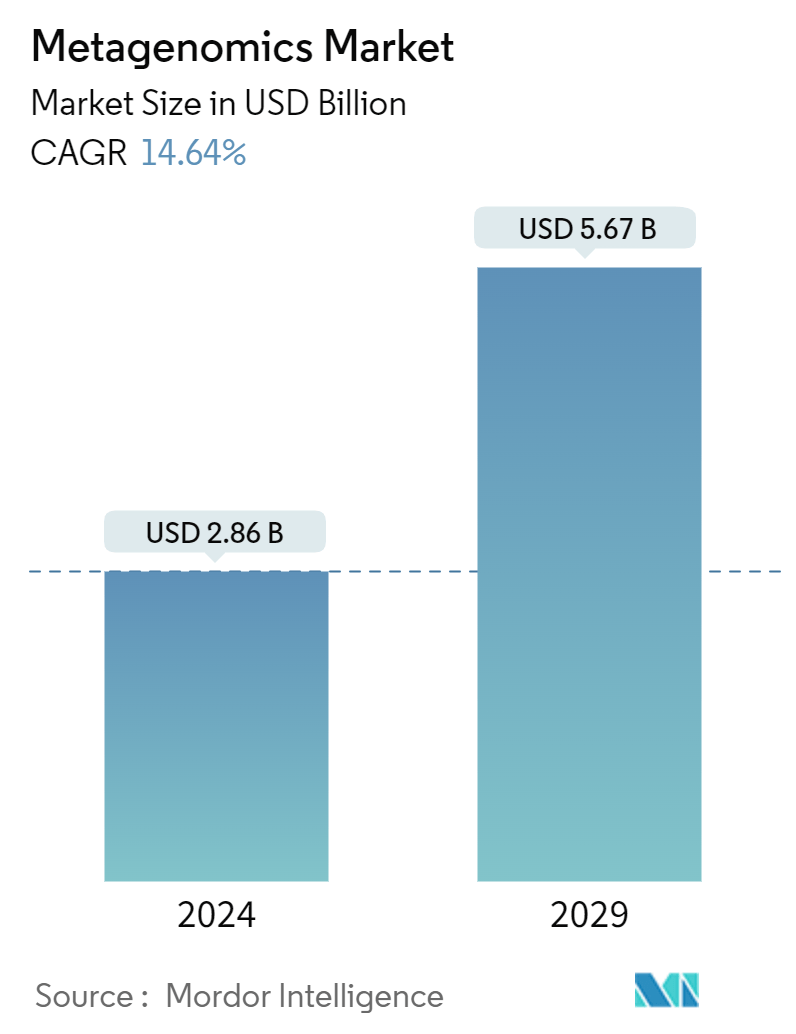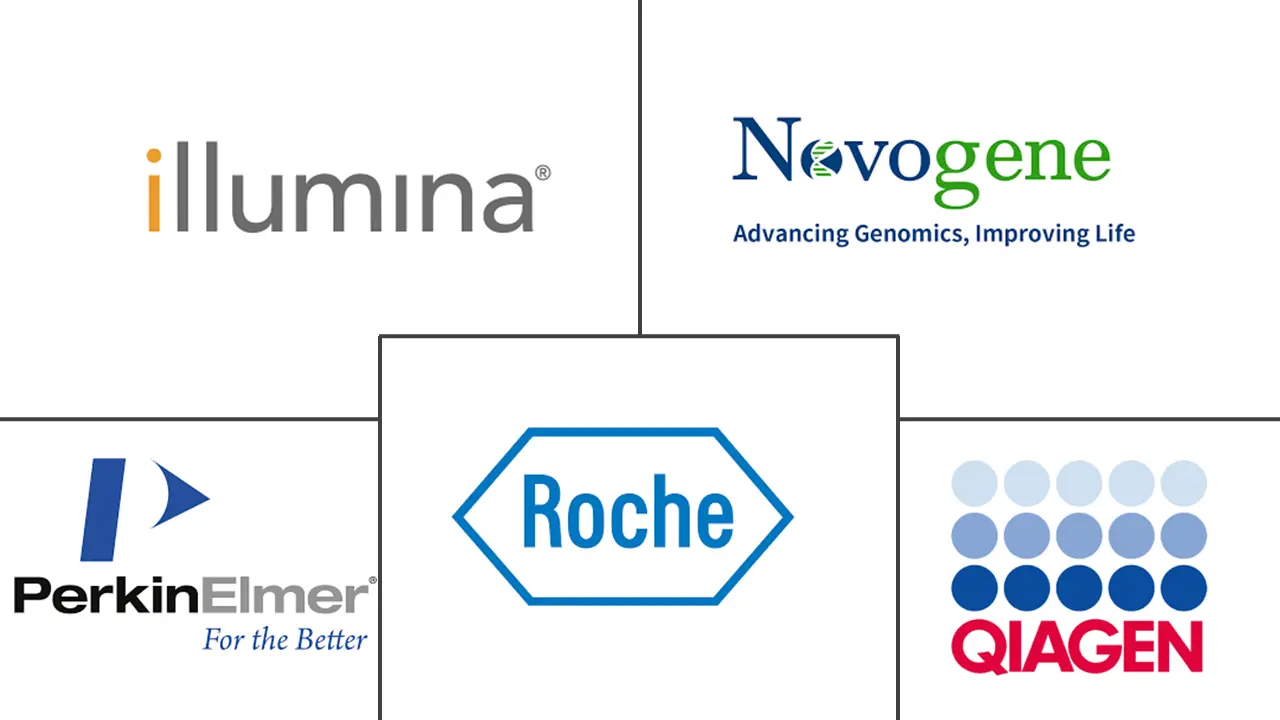Market Size of Metagenomics Industry

| Study Period | 2019 - 2029 |
| Market Size (2024) | USD 2.86 Billion |
| Market Size (2029) | USD 5.67 Billion |
| CAGR (2024 - 2029) | 14.64 % |
| Fastest Growing Market | Asia Pacific |
| Largest Market | North America |
Major Players
*Disclaimer: Major Players sorted in no particular order |
Metagenomics Market Analysis
The Metagenomics Market size is estimated at USD 2.86 billion in 2024, and is expected to reach USD 5.67 billion by 2029, growing at a CAGR of 14.64% during the forecast period (2024-2029).
- The metagenomics market is an emerging and dynamic segment within the life sciences industry, primarily focused on analyzing genetic material directly recovered from environmental samples. This field has garnered significant attention due to its profound ability to explore microbial diversity, enhance pathogen detection, and unravel the roles of microorganisms across various environments. The integration of advanced techniques such as next-generation sequencing (NGS) and sophisticated bioinformatics tools has broadened the applications of metagenomics, impacting sectors such as human health, environmental studies, and microbial ecology.
- Technological Advancements in Sequencing: One of the primary drivers of the metagenomics market is the continuous decline in sequencing costs. Advances in sequencing technologies, particularly next-generation sequencing (NGS), have made high-throughput sequencing more accessible and affordable. This trend has significantly expanded the reach of metagenomics, enabling a wider range of research institutions and companies to engage in large-scale metagenomic studies.
- Rising Research and Development (R&D) Expenditure: The increasing investment in R&D is another critical factor driving market growth. Governments, academic institutions, and private companies are allocating substantial resources to metagenomic research, recognizing its potential to offer insights into microbial ecosystems. The growing interest in the microbiome's role in health, disease, and environmental monitoring fuels this investment, driving demand for advanced metagenomic sequencing and bioinformatics tools.
Expanding Research Expenditure in Metagenomics
- Increasing Global R&D Investments: The surge in global R&D expenditure is a key contributor to the growth of the metagenomics market. Governments, academic institutions, and private companies are increasingly investing in metagenomic research to explore the complexities of microbial ecosystems. These investments are driven by the growing recognition of the importance of the microbiome in health and disease, environmental monitoring, and agriculture.
- Potential for Novel Discoveries: Expanding metagenomics research offers the potential to develop novel therapies, improve pathogen detection, and enhance our understanding of microbial contributions to ecosystem functions. The increasing availability of funding supports collaborative projects and large-scale studies, driving demand for advanced sequencing technologies and bioinformatics tools for metagenomic data analysis.
- Impact on Scientific Advancements: The expanding scope of metagenomic research, coupled with the development of more sophisticated analytical methods, is expected to accelerate the discovery of new microbial species and functional genes, thereby contributing to advancements in multiple scientific disciplines.
Sequencing Costs Continue to Decline
- Impact of Declining Sequencing Costs: The continuous decline in sequencing costs is another crucial driver of the metagenomics market. As the price of sequencing technologies, particularly NGS, continues to decrease, it has become more feasible for researchers and institutions to conduct large-scale metagenomic studies. This affordability is particularly impactful in high-throughput sequencing, such as shotgun sequencing, which is essential for comprehensive microbiome analysis and environmental genomics.
- Increased Access to Metagenomic Workflows: Lower sequencing costs enable broader access to metagenomic workflows, facilitating a greater number of studies and applications. This accessibility is crucial for expanding the adoption of metagenomics in both academic research and clinical settings, where cost constraints have historically limited its use.
- Sustainability of Metagenomic Libraries: The reduction in sequencing expenses also supports the development of metagenomic libraries, which serve as valuable resources for researchers studying microbial diversity and pathogen detection. As sequencing becomes more cost-effective, the creation and maintenance of these libraries become more sustainable, further driving research in microbial ecology and functional metagenomics.
- Challenges in Widespread Adoption: Despite these advancements, the high overall cost of metagenomics remains a significant barrier to its widespread adoption. The expenses related to sequencing equipment, reagents, and data analysis are particularly burdensome for smaller research settings, limiting their ability to fully leverage metagenomic technologies. Addressing these cost challenges is essential for the broader application of metagenomics across various scientific disciplines.
Metagenomics Industry Segmentation
Metagenomics deals with the study in which it acts as a molecular tool that uses sequencing technologies and bioinformatics tools to analyze DNA acquired from environmental samples.
The metagenomics market is segmented by product, technology, application, and technology. By product, the market is segmented by sequencing and data analytics services, kits, reagents, and other products. By technology, the market is segmented by sequencing-driven and function-driven. By application, the market is segmented by human health, environmental, and other applications. By geography, the market is segmented by North America, Europe, Asia-Pacific, Middle East and Africa, and South America. The market report also covers the estimated market sizes and trends for 17 different countries across major regions globally. The report offers the value (in USD) for the above segments.
| By Product | |
| Sequencing and Data Analytics Services | |
| Kits and Reagents | |
| Other Products |
| By Technology | |
| Sequencing Driven | |
| Function Driven |
| By Application | |
| Human Health | |
| Environmental | |
| Other Applications |
| Geography | ||||||||
| ||||||||
| ||||||||
| ||||||||
| ||||||||
|
Metagenomics Market Size Summary
The metagenomics market is poised for significant growth, driven by increasing research and development expenditure, technological advancements, and the declining costs of sequencing. The COVID-19 pandemic has further accelerated market expansion by highlighting the importance of metagenomic sequencing in understanding viral infections and monitoring emerging variants. This has opened up new opportunities for metagenomic technologies, despite the challenges posed by high sequencing costs. The market is characterized by the development of advanced platforms and strategic partnerships, such as those between SYNLAB and Microba Life Sciences, which aim to enhance the availability and application of metagenomic tests across various regions.
North America is expected to dominate the metagenomics market due to the presence of numerous pharmaceutical and biotechnological companies, coupled with substantial research and development investments. The region's growth is further supported by the widespread adoption of metagenomic diagnostics and advancements in next-generation sequencing technologies. Strategic activities, including product launches and partnerships, are anticipated to bolster market demand. Key players in the industry, such as Illumina Inc., QIAGEN NV, and Novogene Co. Ltd., are actively involved in driving innovation and expanding their market presence. These factors collectively contribute to the robust growth trajectory of the metagenomics market over the forecast period.
Metagenomics Market Size - Table of Contents
-
1. MARKET DYNAMICS
-
1.1 Market Overview
-
1.2 Market Drivers
-
1.2.1 Increasing R&D Expenditure
-
1.2.2 Declining Expenses of Sequencing
-
1.2.3 Technological Advancements
-
-
1.3 Market Restraints
-
1.3.1 High Overall Cost of Metagenomics
-
-
1.4 Porter's Five Forces Analysis
-
1.4.1 Threat of New Entrants
-
1.4.2 Bargaining Power of Buyers/Consumers
-
1.4.3 Bargaining Power of Suppliers
-
1.4.4 Threat of Substitute Products
-
1.4.5 Intensity of Competitive Rivalry
-
-
-
2. MARKET SEGMENTATION (Market Size by Value - USD)
-
2.1 By Product
-
2.1.1 Sequencing and Data Analytics Services
-
2.1.2 Kits and Reagents
-
2.1.3 Other Products
-
-
2.2 By Technology
-
2.2.1 Sequencing Driven
-
2.2.2 Function Driven
-
-
2.3 By Application
-
2.3.1 Human Health
-
2.3.2 Environmental
-
2.3.3 Other Applications
-
-
2.4 Geography
-
2.4.1 North America
-
2.4.1.1 United States
-
2.4.1.2 Canada
-
2.4.1.3 Mexico
-
-
2.4.2 Europe
-
2.4.2.1 Germany
-
2.4.2.2 United Kingdom
-
2.4.2.3 France
-
2.4.2.4 Italy
-
2.4.2.5 Spain
-
2.4.2.6 Rest of Europe
-
-
2.4.3 Asia-Pacific
-
2.4.3.1 China
-
2.4.3.2 Japan
-
2.4.3.3 India
-
2.4.3.4 Australia
-
2.4.3.5 South Korea
-
2.4.3.6 Rest of Asia-Pacific
-
-
2.4.4 Middle East and Africa
-
2.4.4.1 GCC
-
2.4.4.2 South Africa
-
2.4.4.3 Rest of Middle East and Africa
-
-
2.4.5 South America
-
2.4.5.1 Brazil
-
2.4.5.2 Argentina
-
2.4.5.3 Rest of South America
-
-
-
Metagenomics Market Size FAQs
How big is the Metagenomics Market?
The Metagenomics Market size is expected to reach USD 2.86 billion in 2024 and grow at a CAGR of 14.64% to reach USD 5.67 billion by 2029.
What is the current Metagenomics Market size?
In 2024, the Metagenomics Market size is expected to reach USD 2.86 billion.

